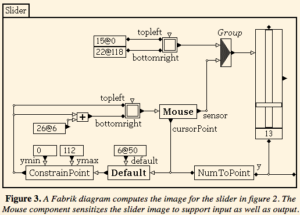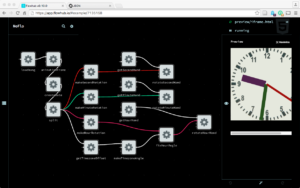In an earlier post, I wrote about flow based programming (FBP). Recently, I ran across Fabrik, which was one of the first visual tools for FBP. One inspiration for Fabrik was Show and Tell.
In chemical engineering we wire, or rather pipe, visual components together in application-specific software tools to design chemical processes (see Resources, COCO Simulator here) and process control systems (Matlab Simulink).
“Fabrik – A Visual Programming Environment”
Dan Ingalls, Scott Wallace, Yu-Ying Chow, Frank Ludolph, Ken Doyle of Apple Computer.
presented at ACM, OOPSLA 1988 Conference Proceedings
http://web.archive.org/web/20080511202219/http://users.ipa.net/~dwighth/smalltalk/Fabrik/Fabrik.html
“Fabrik is a visual programming environment – a kit of computational and user-interface components that can be “wired” together to build new components and useful applications. … A kit is a set of primitive components, together with a framework for connecting the components to do new and interesting things…. The kit approach has been around for a long time, manifest in the subroutine libraries of the last three decades. However, the ability to browse through, and experiment with the available components was extremely primitive, owing to the textual orientation of underlying computing environments during those early years. … With the advent of iconic user interfaces, nontechnical users — those not trained to appreciate invisible objects and connections — are able to work concretely (by pointing at an image) with data and functional components.”


